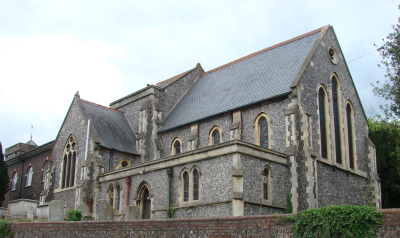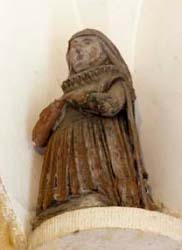Lewes – All Saints, Friars Walk
All Saints is near the site of the Grey Friars, a friary which was dissolved in 1538. A renewed C15 gateway east of the churchyard may come from this (VCH 2 p96). The date of the first parish church is unknown but is likely to be early. On the evidence of the Sharpe Collection drawing (probably 1804 or 1805) and in particular the windows, which include a three-light east one with panelled tracery, the then church was mostly C15. A two-storey south porch has a hipped roof. All that remains is the diminutive west tower, with diagonal buttresses and a four-centred west doorway, which dates it to the late C15, as do the two-light square-headed bell-openings and plain parapet; the west window can only be seen in outline on the drawing. Though a parapet is shown on the Sharpe drawing, it is said to replace battlements (ibid). The form of the tower arch, which is suitably small with a double chamfered head and semi-octagonal responds, is consistent with the date.
The parishes of St Nicholas, St-Peter-the-Less and Holy Trinity, amalgamated with All Saints after the Reformation (Horsfield, Lewes I p211), were all poor and as the church was in bad condition (ibid I pp283-84), it was decided in 1805 to rebuild it (WSRO Ep II/27/25). The architect was A Wilds senior (Colvin 4th ed p1119) before he moved to Brighton. To the retained tower he attached a nave of utilitarian brick with two tiers of windows and inside there are galleries on thin iron columns and a plain coved plaster ceiling. When built, it had a shallow three-sided east end (WSRO Ep II/27/127). Such a church found little favour with the Victorians, though in 1872 B Ingelow reseated it (BN 22 p513) at a cost of £800 (KD 1899). As the first part of a projected replacement, in 1883 W Bassett-Smith and E J Munt designed a chancel of flint with lower transepts and the first bay of a new nave (BN 44 p489). Their work, which cost £3500 (KD 1899), has geometrical tracery and lancets and makes no concession to Wilds’s work. Inside, the big moulded chancel and transept arches are equally assertive. Nothing more was built except in 1899 when W Bassett-Smith returned to add vestries to the south, this time with his son C A Bassett-Smith (CDG 61).
In use until 1975 (CCC), the church has now been adapted as an arts and community centre. The stage is in the curtained-off chancel and the nave has become the auditorium, which has been redecorated with the gallery fronts in light blue. The area at the west end beneath the gallery has been partitioned off to provide cloakrooms etc.
Fittings and monuments
NB. Since it ceased to be used as a church, some fittings (e g the fonts) have been removed or are concealed in the eastern parts (e g the stained glass).
Fonts:
1. Plain baluster of 1806.
2. Later C19 carved octagonal.
Figures: (Still in tower above arch) Two C18 painted figures of charity children from the National School in what is now Station Street (W H Godfrey: History of Lewes p41).
Glass:
1. (East window) Clayton and Bell, 1883 (Te Deum) (BN 44 ibid).
2. (South transept, south window) Clayton and Bell, 1883 (ibid p610).
3. (North transept) J Powell and Sons, 1883 (ibid p910), designed by H Holiday (Hadley).
4. (North chancel, first window) Clayton and Bell, 1884 (www.stainedglassrecords.org retrieved on 11/3/2013).
Monuments:
1. (Mounted in the tower) Robert Hazzard (d1624) and wife. Only the kneeling effigies survived the rebuilding of 1805.
2. John Stansfield (d1627) and wife – see under St Michael, South Malling. The kneeling effigies and the arms and inscription remain, though re-arranged (1 p1).
Reredoses:
1. (West gallery) Parts only of that of 1806.
2. 1891 by J Powell and Sons (Hadley list)
Royal Arms: George III of cast iron.
Source
1. W H Godfrey: The Stansfield Effigies, Lewes, SNQ 7 (Feb 1938) pp1-2
My thanks to Nick Wiseman for the photographs of the effigies and the stained glass.






